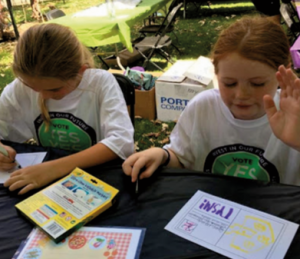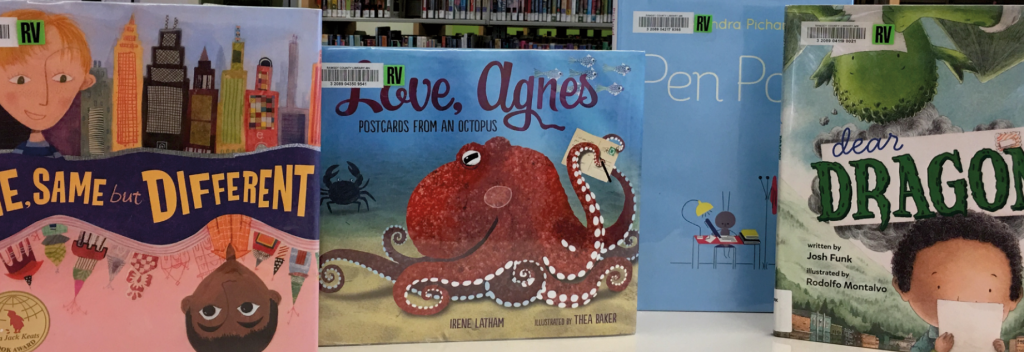10 Letters & Postcards, Emails, Facebook, Twitter, & Text Messages
It is not unusual to hear moans of pain and sighs of dread from young participants when we announce that we’ll be writing letters. Letter writing often means an adult standing over a child, insisting on correct format and punctuation while the child grips a pen to squeeze out a few words of gratitude for that itchy hand-knit Christmas sweater—a moment enjoyed by neither adult nor child.
My favorite mentor text for letter writing is the short story “Your Question for the Author Here,” by Kate DiCamillo and Jon Scieszka in Guys Read: Funny Business. In the story, a student’s homework assignment is to write to a famous author. The audio of Kate and Jon reading the letters is snarky good fun and less than five minutes long. I sometimes begin a Writing Box session reading a portion aloud or playing the authors’ reading for inspiration.
There is no more authentic form of writing than the letter or postcard. A message on a piece of paper that arrives unexpectedly is a joy. Writing a letter or postcard is an intentional act that says to the recipient “You are important to me. I was thinking about you. I have news for you.”

Families and friends also, of course, keep in touch electronically through email and Facebook. Many of our young writers do a significant amount of their writing and reading through emails, Instagram, Twitter, text messages, and other electronic formats. But we must recognize that many of our populations do not have electronic access. We have therefore chosen to go lowtech for this Writing Box program. The blank space on a postcard is finite, and not as overwhelming in size as a blank piece of paper. And handcrafted postcards can be sent through the US Postal Service when postage is attached.
Our postcard session in the public library was especially popular with adult participants, and there was high interest among writers for whom English was a second language, who were eager to send their postcards to family and friends back home.

Mentor texts
Ada, Alma Flor, and Leslie Tryon. 2001. With Love, Little Red Hen. New York: Atheneum Books for Young Readers.
Ahlberg, Janet, and Allan Ahlberg. 1986. The Jolly Postman, or, Other People’s Letters. Boston: Little, Brown.
Benke, Karen. 2015. Write Back Soon! Adventures in Letter Writing. Boston; London: Roost Books.
Berger, Samantha, and Julia Patton. 2018. Snail Mail. New York: Running Press Kids.
Campbell, Rod. 2007. Dear Zoo: A Lift-the-Flap Book. New York: Little Simon.
Cleary, Beverly, and Paul O. Zelinsky. 1983. Dear Mr. Henshaw. New York: Morrow.
Danziger, Paula, and Ann M. Martin. 1998. P.S. Longer Letter Later. New York: Scholastic Press.
Danziger, Paula, and Ann M. Martin. 2000. Snail Mail No More. New York: Scholastic Press.
Gil, L. M. 2014. Letters from Heaven = Cartas Del Cielo. Houston, TX: Piñata Books, Arte Público Press.
Hesse, Karen. 1992. Letters from Rifka. New York: H. Holt.
Holt, Kimberly Willis. 2015. Dear Hank Williams. New York: Henry Holt and Company.
Hopkins, Lee Bennett, and Renée Flower. 2000. Yummy!: Eating through a Day: Poems. New York: Simon & Schuster Books for Young Readers.
House, Silas, and Neela Vaswani. 2012. Same Sun Here. Somerville, MA: Candlewick Press.
Jones, Kelly, and Katie Kath. 2015. Unusual Chickens for the Exceptional Poultry Farmer. New York: Alfred A. Knopf.
Klise, Kate, and M. Sarah Klise. 2004. Regarding the Sink: Where, Oh Where, Did Waters Go? Orlando, FL: Gulliver Books/Harcourt.
Klise, Kate, and M. Sarah Klise. 2009. Dying to Meet You. Boston: Harcourt.
Loewen, Nancy, and Christopher Lyles. 2009. Sincerely Yours: Writing Your Own Letter, Writer’s Toolbox. Minneapolis, MN Picture Window Books.
Mazer, Anne, Ellen Potter, and Matt Phelan. 2010. Spilling Ink: A Young Writer’s Handbook. New York: RB Flash Point/Roaring Brook Press.
McDonald, Megan, and Peter H. Reynolds. 2006. Stink and the Incredible Super-Galactic Jawbreaker. Cambridge, MA: Candlewick Press.
Moyle, Eunice, and Sabrina Moyle. 2017. Happy Mail. Lake Forest, CA: Walter Foster, Jr.
Orloff, Karen Kaufman, and David Catrow. 2004. I Wanna Iguana. New York: Putnam.
Pak, Soyung, and Susan Kathleen Hartung. 1999. Dear Juno. New York: Viking.
Pattison, Darcy, and Joe Cepeda. 2003. The Journey of Oliver K. Woodman. San Diego: Harcourt.
Pennypacker, Sara, and Marla Frazee. 2008. Clementine’s Letter. New York: Hyperion Books for Children.
Ruzzier, Sergio. 2014. A Letter for Leo. Boston: Clarion Books, Houghton Mifflin Harcourt.
Scieszka, Jon, and Adam Rex. 2010. Guys Read: Funny Business. New York: Walden Pond Press.
Sís, Peter. 2015. Ice Cream Summer. New York: Scholastic Press.
Standiford, Natalie, and Nathan Durfee. 2016. The Only Girl in School. New York: Scholastic Press.
Tonatiuh, Duncan. 2010. Dear Primo: A Letter to My Cousin. New York: Abrams Books for Young Readers.
Williams, Vera B. 1981. Three Days on a River in a Red Canoe. New York: Greenwillow Books.
Williams-Garcia, Rita. 2013. P.S. Be Eleven. New York, NY: Amistad.
Woodson, Jacqueline. 2009. Peace, Locomotion. New York, NY: G.P. Putnam’s Sons.
Resources
Chohan, Sukhdeep Kaur. 2011. “Any Letter for Me? Relationships between an Elementary School Letter Writing Program and Student Attitudes, Literacy Achievement, and Friendship Culture.” Early Childhood Education Journal 39 (1):39-50.
Jackson, Roberta M. 1992. “The Untapped Power of Student Note Writing.” Educational Leadership 49 (7):54-58.
Johns, Jerry L, and Thomas E Wheat. 1984. “Newspaper Readability: Two Crucial Factors.” Journal of Reading 27 (5):432-434. z.umn.edu/wbr59.
LeVine, Judith E. 2002. “Writing Letters to Support Literacy.” The Reading Teacher 56 (3):232.

